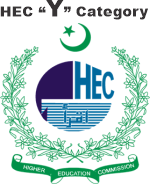ENFORCEMENT OF TRADEMARKS AND COPYRIGHTS UNDER IP LAW: A CRITICAL ANALYSIS
Keywords:
Enforcement, Trademarks, Copyrights, IP LawAbstract
Both trademarks and copyright are forms of intellectual property protection that provide their respective owners with the right to prevent others from using their work without their permission. The goods and services of one source may be distinguished from those of others by the use of distinctive signs, designs, or expressions that are trademarks. Words, phrases, logos, symbols, or even combinations of these are all acceptable. Trademarks play an important role in establishing brand recognition and loyalty among customers. A trademark's principal function is to prohibit third parties from using a mark that is confusingly similar to the registered trademark. Although some trademark rights can be established through common law use, registration with the relevant trademark office is the usual method for acquiring such rights. Working closely with intellectual property professionals to develop comprehensive protection and enforcement strategies, keeping up-to-date on changes in intellectual property laws, implementing proactive monitoring strategies, educating employees and stakeholders about intellectual property rights, and enforcing intellectual property rights are all necessary responses. (Bonadio & Weissenberger, 2021) It's important to keep in mind that the precise difficulties and problems might differ depending on the kind of company, the sector, and the location. Insight into them is provided in this article.
References
M. (2012). Rethinking the Anti-Counterfeiting Trade Agreement's Criminal Copyright Enforcement Measures. J. Crim. L. & Criminology, 102, 67.
Bonadio, E., & Weissenberger, N. (2021). Food Presentations and Recipes: Is There a Space for Copyright and Other Intellectual Property Rights? Enrico Bonadio–Natalie Weissenberger, Food Presentations and Recipes: is there a Space for Copyright and other Intellectual Property Rights.
Çağlayan Aksoy, P., & Özkan Üner, Z. (2021). NFTs and copyright: challenges and opportunities. Journal Of Intellectual Property Law and Practice, 16(10), 1115-1126.
Calboli, I. (2022). Intellectual property exhaustion and parallel imports of pharmaceuticals: A comparative and critical review. Access to Medicines and Vaccines, 31.
Chisum, D. S. (1996). Normative and empirical territoriality in intellectual property: Lessons from patent law. Va. J. Int'l L., 37, 603.
Geoffroy-Schwinden, R. D. (2018). Music, Copyright, and Intellectual Property during the French Revolution: A Newly Discovered Letter from André-Ernest-Modeste Grétry. Transposition. Musique et Sciences Sociales(7).
Geyer, S. (2017). Copyright in traditional works: unravelling the Intellectual Property Laws Amendment Act of 2013. SA Mercantile Law Journal, 29(1), 43-65.
Gilani, S. R. S. (2019). The significance of the doctrine of proportionality in the context of militant democracy to protect the freedom of expression Brunel University London].
Gilani, S. R. S., Ali, M. A., & Zahoor, M. S. (2023). Limitations on Parliamentary Sovereignty in the UK: A Critical Analysis. Journal of European Studies (JES), 39(1), 47-47.
Gilani, S. R. S., Khan, I., & Zahoor, S. (2021). The Historical Origins of the Proportionality Doctrine as a tool of Judicial Review: A Critical Analysis. Research Journal of Social Sciences and Economics Review, 2(1), 251-258.
Gilani, S. R. S., & Rehman, H. U. (2020). The Limitation Clauses On Human Rights and Fundamental Freedoms: The Role of the Court of Justice of the European Union (CJEU). Journal of European Studies (JES), 36(2), 83-99.
Hofmeyr, I. (2018). Colonial copyright, customs, and port cities: Material histories and intellectual property. Comparative Literature, 70(3), 264-277.
Landes, W. M., & Posner, R. A. (2003). The economic structure of intellectual property law. Harvard university press.
Niqresh, M. (2019). Digital Library and Intellectual Issues--Issues in Copyright and Intellectual Property. International Education Studies, 12(1), 114-127.
Okonkwo, I. E. (2021). NFT, copyright and intellectual property commercialization. International Journal of Law and Information Technology, 29(4), 296-304.
Ostergard, R. L. (2000). The measurement of intellectual property rights protection. Journal of International Business Studies, 31, 349-360.
Picciotto, S. (2006). The WTO as a Node of Global Governance: Economic Regulation and Human Rights Discourses. Human Rights and Global Justice.
Ríos, G. R., & Sackey, D. J. (2015). Biocultural diversity and copyright: Linking intellectual property, language, knowledges, and environment. Cultures of copyright, 211-225.
Sanusi, B. O. (2016). Awareness of plagiarism as copyright violation with implications for intellectual property education in tertiary learning.
Schwartz, D. L., & Sichelman, T. (2019). Data sources on patents, copyrights, trademarks, and other intellectual property. In Research handbook on the economics of intellectual property law (pp. 2-17). Edward Elgar Publishing.
Stokes, S. (2021). Art and copyright. Bloomsbury Publishing.
Uphoff, E. (2018). Intellectual property and US relations with Indonesia, Malaysia, Singapore, and Thailand. Cornell University Press.

Downloads
Published
Issue
Section
License
Copyright (c) 2023 PAKISTAN ISLAMICUS (An International Journal of Islamic & Social Sciences)

This work is licensed under a Creative Commons Attribution 4.0 International License.
This work is licensed under a Creative Commons Attribution 4.0 International License.

































